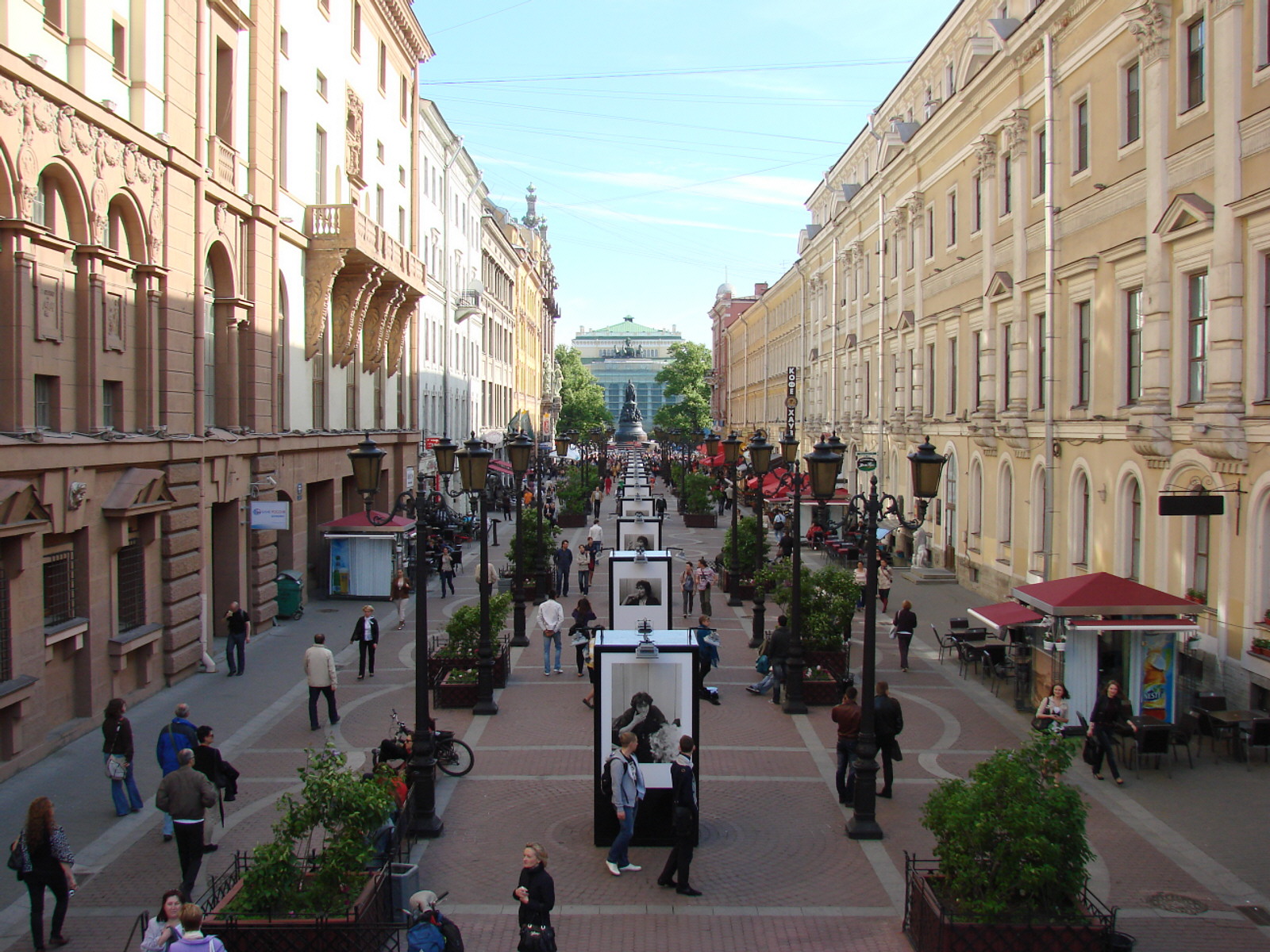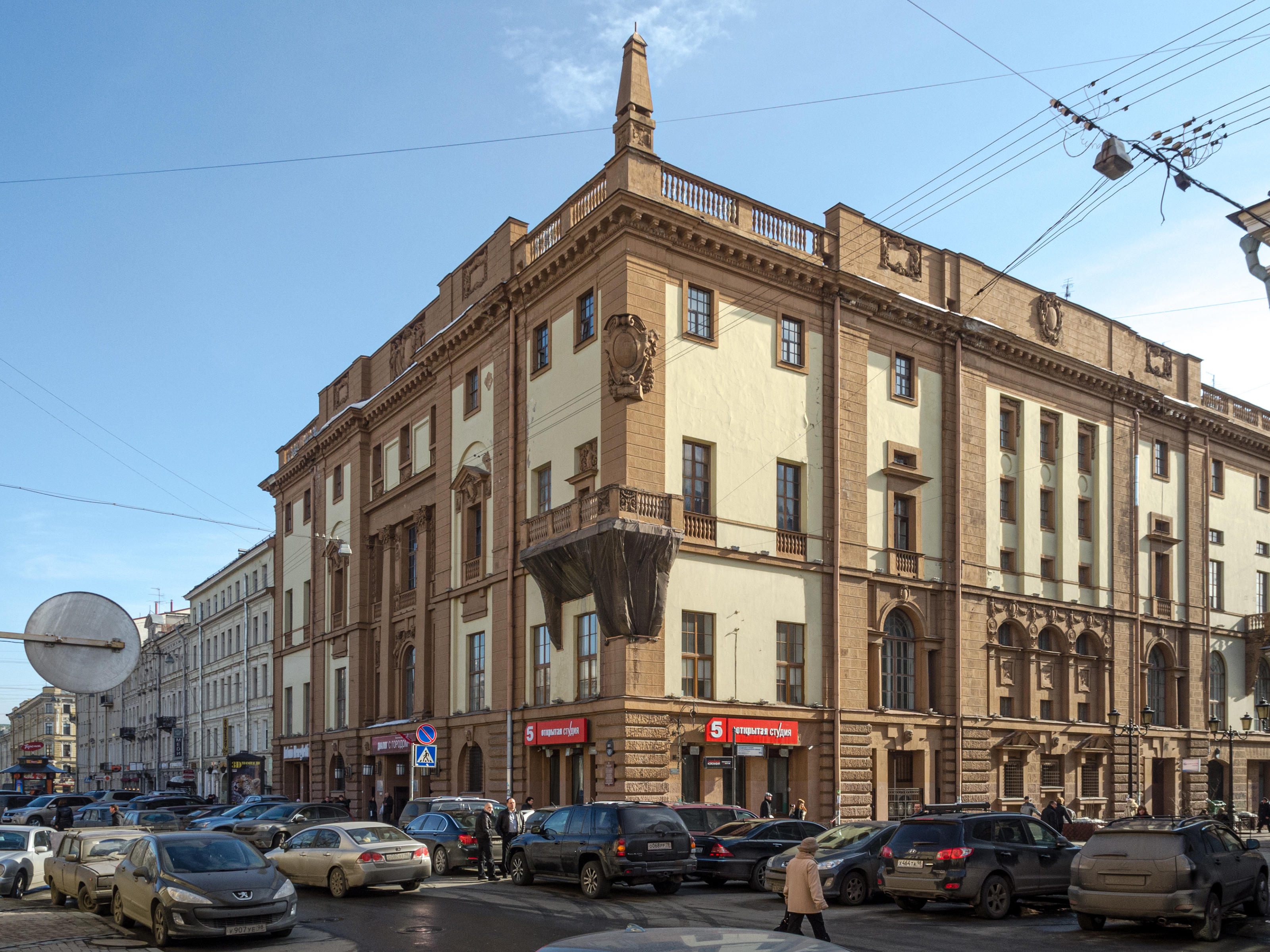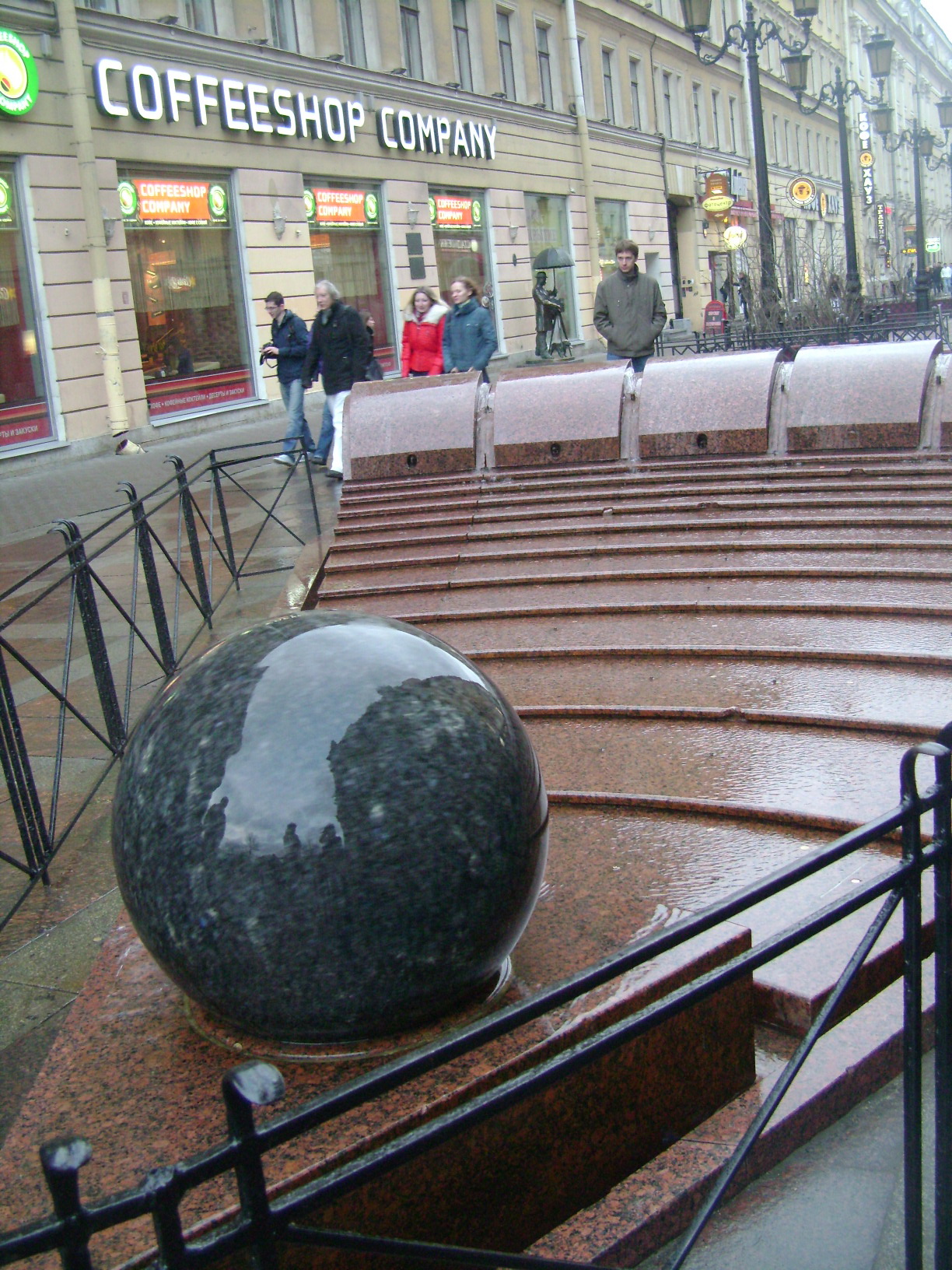Malaya Sadovaya Street on:
[Wikipedia]
[Google]
[Amazon]
 Malaya Sadovaya Street (russian: Малая Садовая Улица, meaning 'Little Garden Street') is a pedestrian street of cafes, terraces and fountains in the heart of
Malaya Sadovaya Street (russian: Малая Садовая Улица, meaning 'Little Garden Street') is a pedestrian street of cafes, terraces and fountains in the heart of
 The at 1 Malaya Sadovaya/25 Italyanskaya was designed by the architect
The at 1 Malaya Sadovaya/25 Italyanskaya was designed by the architect
 With the coming of World War I, the Japanese Red Cross set up a hospital in the building for severely wounded soldiers. Japanese doctors, nurses, and pharmacists worked here together with their Russian counterparts, and the staff took pride in the low mortality rate achieved – 6 deaths among the 500 patients admitted. Among the nurses was the wife of the Japanese Ambassador
With the coming of World War I, the Japanese Red Cross set up a hospital in the building for severely wounded soldiers. Japanese doctors, nurses, and pharmacists worked here together with their Russian counterparts, and the staff took pride in the low mortality rate achieved – 6 deaths among the 500 patients admitted. Among the nurses was the wife of the Japanese Ambassador
 The Demidov House was built in the 18th Century at the corner of Malaya Sadovaya Street and Nevsky Prospect (3 Malaya Sadovaya/54 Nevsky Prospect). In the 19th Century, the house underwent two major renovations. The first was in 1841 to a design by . Later, the architect
The Demidov House was built in the 18th Century at the corner of Malaya Sadovaya Street and Nevsky Prospect (3 Malaya Sadovaya/54 Nevsky Prospect). In the 19th Century, the house underwent two major renovations. The first was in 1841 to a design by . Later, the architect
 At the corner of Malaya Sadovaya Street and Nevsky Prospect (8 Malaya Sadovaya/56 Nevsky Prospect) is the Elisseeff Emporium, designed in the
At the corner of Malaya Sadovaya Street and Nevsky Prospect (8 Malaya Sadovaya/56 Nevsky Prospect) is the Elisseeff Emporium, designed in the
 In 1999 Malaya Sadovaya Street was turned into a pedestrian zone. The street was paved with tiles, the separation between street and sidewalk was removed, benches were added, pipes were laid under the streets carrying heated water to keep the street free of snow and ice, and a fountain featuring a
In 1999 Malaya Sadovaya Street was turned into a pedestrian zone. The street was paved with tiles, the separation between street and sidewalk was removed, benches were added, pipes were laid under the streets carrying heated water to keep the street free of snow and ice, and a fountain featuring a
Malaya Sadovaya Street article at the Encyclopedia of St. Petersburg
* ttp://petersburgcity.com/city/photos/streets/sadovaya/ Contemporary photographs of Malaya Sadovaya Street at PetersburgCitybr>Photograph of one of the Malaya Sadovaya Street catsNational Geographic description of area with map
Map showing Malaya Sadovaya Street at maps.yandex.ru
* {{in lang, ru Streets in Saint Petersburg Pedestrian zones of Saint Petersburg
Saint Petersburg
Saint Petersburg ( rus, links=no, Санкт-Петербург, a=Ru-Sankt Peterburg Leningrad Petrograd Piter.ogg, r=Sankt-Peterburg, p=ˈsankt pʲɪtʲɪrˈburk), formerly known as Petrograd (1914–1924) and later Leningrad (1924–1991), i ...
, Russia. It runs between Italyanskaya Street (Italian Street) and the Nevsky Prospect
Nevsky Prospect ( rus, Не́вский проспе́кт, r=Nevsky Prospekt, p=ˈnʲɛfskʲɪj prɐˈspʲɛkt) is the main street (high street) in the federal city of St. Petersburg in Russia. It takes its name from the Alexander Nevsky La ...
. Spanning a single block, at about , it is known as Saint Petersburg's shortest street.
The street's Nevsky Prospect terminus is at Catherine Square, which features the monument to Catherine the Great
, en, Catherine Alexeievna Romanova, link=yes
, house =
, father = Christian August, Prince of Anhalt-Zerbst
, mother = Joanna Elisabeth of Holstein-Gottorp
, birth_date =
, birth_name = Princess Sophie of Anhal ...
by the sculptors Mikhail Mikeshin
Mikhail Osipovich Mikeshin (russian: Михаил Осипович Микешин; 1835–1896) was a Russian artist who regularly worked for the Romanov family and designed a number of outdoor statues in the major cities of the Russian Empire.
...
and Matthew Chizhov
Matthew Afanasyevich Chizhov (russian: Матвей Афанасьевич Чижов) (1838–1916) was a Russian sculptor.
Biography
Chizhov was born the son of a peasant mason on November 10, 1838 in the village of Pudov in the Podolsky Dist ...
, and the architects Victor Schröter
Victor Alexandrovich Schröter (russian: Виктор Александрович Шрётер; 1839–1901) was a prominent Russian architect of German ethnicity.
Career
Schröter was born 27 April 1839, in St. Petersburg of Baltic Germans, Balti ...
and David Grimm. At the Italyanskaya Street terminus is Manezhnaya Square, where there is a view of the portico of the great stables designed by Vincenzo Brenna
Vincenzo Brenna (1747Lanceray, p. 37, states birth year as 1745. Contemporary historians (Dmitry Shvidkovsky) agree on 1747 (Shvidkovsky, p. 293) – May 17, 1820) was an Italian architect and painter who was the house architect of Paul I of Russ ...
and Karl Rossi.
History
The street, then called New Lane (russian: Новым переулком), was first made in the 1740s. A palace belonging toIvan Shuvalov
Ivan Ivanovich Shuvalov (russian: link=no, Ива́н Ива́нович Шува́лов; 1 November 172714 November 1797) was called the Maecenas of the Russian Enlightenment and the first Russian Minister of Education. Russia's first theatre ...
was built here, completed in 1756, after which the street was called Shuvalov Lane. All the odd side of the street was owned by Shuvalov. His palace was at the corner of Italian Street, after which there was a small fenced garden. From this the street began to be called Little Garden Street from about 1850.
The street was a favored walking venue for Alexander II. In 1873, the street was renamed to Catherine Street in honor of Catherine the Great. It kept this name until the 1917 Revolution
The Russian Revolution was a period of political and social revolution that took place in the former Russian Empire which began during the First World War. This period saw Russia abolish its monarchy and adopt a socialist form of government ...
.
In September 1918, a number of streets and squares in Petersburg were renamed, and Catherine Street was renamed Proletkulta Street, after the cultural, educational, and literary organization Proletkult
Proletkult ( rus, Пролетку́льт, p=prəlʲɪtˈkulʲt), a portmanteau of the Russian words "proletarskaya kultura" (proletarian culture), was an experimental Soviet artistic institution that arose in conjunction with the Russian Revolut ...
which at the time was housed on the street, at Number 2. But after World War II, most of these streets were returned to their historical names, and in 1949, Proletkulta Street again became Malaya Sadovaya Street.
Notable buildings
Shuvalov Mansion
 The at 1 Malaya Sadovaya/25 Italyanskaya was designed by the architect
The at 1 Malaya Sadovaya/25 Italyanskaya was designed by the architect Savva Chevakinsky
Savva Ivanovich Chevakinsky (russian: Савва Иванович Чевакинский; 1709 – aft. 1774) was a Russian architect of the Baroque school. He worked in Saint Petersburg and Tsarskoye Selo.
Chevakinsky was born into a noble famil ...
for Ivan Shuvalov
Ivan Ivanovich Shuvalov (russian: link=no, Ива́н Ива́нович Шува́лов; 1 November 172714 November 1797) was called the Maecenas of the Russian Enlightenment and the first Russian Minister of Education. Russia's first theatre ...
and constructed in 1749–1756. From 1802 to 1917, it housed the Ministry of Justice of the Russian Empire
The Ministry of Justice was one of the Russian Empire's central public institutions and was established on 8 September 1802. The ministry was headed by the Minister of Justice (who was at the same time the Senate Procurator General).
Structure
* ...
. An addition to the middle part of the ministry building was constructed in 1845–1849; the initial design was by Fyodor Braun and the project was completed by Dmitry Efimov
Dmitri (russian: Дми́трий); Church Slavic form: Dimitry or Dimitri (); ancient Russian forms: D'mitriy or Dmitr ( or ) is a male given name common in Orthodox Christian culture, the Russian version of Greek Demetrios (Δημήτριο ...
.
From 1875 to 1927, the jurist Anatoly Koni
Anatoly Fedorovich Koni (Russian: Анато́лий Фёдорович Ко́ни; 9 February 1844 – 17 September 1927) was a Russian jurist, judge, politician and writer. He was the most politically influential jurist of the late Russian Empir ...
lived in the building. Later, it housed the Public Health Committee of St. Petersburg and the , which is still there today.
Radio House
Across the street, at 2 Malaya Sadovaya/27 Italyanskaya, the architect brothers Vasily Kosyakov, , and designed a building for the Saint Petersburg Assembly of Nobles, which was constructed in 1912–1914. With the coming of World War I, the Japanese Red Cross set up a hospital in the building for severely wounded soldiers. Japanese doctors, nurses, and pharmacists worked here together with their Russian counterparts, and the staff took pride in the low mortality rate achieved – 6 deaths among the 500 patients admitted. Among the nurses was the wife of the Japanese Ambassador
With the coming of World War I, the Japanese Red Cross set up a hospital in the building for severely wounded soldiers. Japanese doctors, nurses, and pharmacists worked here together with their Russian counterparts, and the staff took pride in the low mortality rate achieved – 6 deaths among the 500 patients admitted. Among the nurses was the wife of the Japanese Ambassador Motono Ichirō
was a statesman and diplomat, active in Meiji period Japan.
Biography
Motono was born in Saga, Hizen Province, (modern-day Saga Prefecture). His father, an entrepreneur, was one of the founders of the modern Yomiuri Shimbun. Motono studied law ...
. Soon, the sprawling hospital took over the whole building, except for the theater hall and several rooms reserved for the Noble Assembly. The Japanese left in April 1916.
In 1918, the Proletkult
Proletkult ( rus, Пролетку́льт, p=prəlʲɪtˈkulʲt), a portmanteau of the Russian words "proletarskaya kultura" (proletarian culture), was an experimental Soviet artistic institution that arose in conjunction with the Russian Revolut ...
organization took over the building. During this time, the actor, director, and founder of the Petroproletkulta Theater, , worked here. In 1930, Proletarian Culture was disbanded, and beginning in 1933, the building housed . This was active during the Siege of Leningrad
The siege of Leningrad (russian: links=no, translit=Blokada Leningrada, Блокада Ленинграда; german: links=no, Leningrader Blockade; ) was a prolonged military blockade undertaken by the Axis powers against the Soviet city of L ...
, and Radio Committee employees lived, worked, and died here. From here, they supported the Leningraders with their transmissions, and Olga Bergholz
Olga Fyodorovna Bergholz ( rus, Ольга Фёдоровна Берггольц, p=ˈolʲɡə ˈfʲɵdərəvnə bʲɪrˈɡolʲts, a=Ol'ga Fyodorovna Byerghol'cz.ru.vorb.oga; – November 13, 1975) was a Soviet Union, Soviet and Russian Soviet F ...
, the muse of the embattled city, read her poems and speeches.
On September 7, 1993, the Legislative Assembly of Saint Petersburg
The Legislative Assembly of Saint Petersburg (russian: Законода́тельное собра́ние Санкт-Петербу́рга, ЗакС) is the regional parliament of Saint Petersburg, a federal subject (federal city) of Russia ...
declared Radio House a monument of historical, cultural, and architectural significance. A plaque to the courage of the workers of Radio Leningrad during the siege now adorns the building entrance.
The studios of Channel 5 are housed there now. The street outside is sometimes used by the station as the site of "man in the street" interviews of passersby.
Demidov House
 The Demidov House was built in the 18th Century at the corner of Malaya Sadovaya Street and Nevsky Prospect (3 Malaya Sadovaya/54 Nevsky Prospect). In the 19th Century, the house underwent two major renovations. The first was in 1841 to a design by . Later, the architect
The Demidov House was built in the 18th Century at the corner of Malaya Sadovaya Street and Nevsky Prospect (3 Malaya Sadovaya/54 Nevsky Prospect). In the 19th Century, the house underwent two major renovations. The first was in 1841 to a design by . Later, the architect Pavel Suzor
Count Pavel Yulievich Suzor (russian: Павел Юльевич Сюзор, French: Paul-Jules Persin comte Suzor, gw.geneanet.org 1844–1919) was a Russian architect, president of the Architects Society, and count.
Biography
Count Paul-Ju ...
designed a major reconstruction with new facades, which was undertaken in 1882–1883.
Later, the building went into the possession of A. Ushokov and became an apartment house. The singer Pauline Viardot-Garcia
Pauline Viardot (; 18 July 1821 – 18 May 1910) was a nineteenth-century French mezzo-soprano, pedagogue and composer of Spanish descent.
Born Michelle Ferdinande Pauline García, her name appears in various forms. When it is not simply "Paul ...
lived here in 1843, and the photographer Karl Bulla
Carl Oswald Bulla or Karl Karlovich Bulla (russian: Карл Карлович Булла; 26 February 1855
in Encycl ...
had his studio here. Today, the building houses a small museum dedicated to Bulla.
In 2000, the Expert Committee recommended that this building be placed on the list of newly identified sites of historical, scientific, artistic or other cultural value and included in the list of monuments of history and culture.
in Encycl ...
Armyaninova House
At 4 Malaya Sadovaya Street is the Armyaninova House. Here in 1828 lived the poet Ivan Kozlov, a contemporary ofPushkin
Alexander Sergeyevich Pushkin (; rus, links=no, Александр Сергеевич ПушкинIn pre-Revolutionary script, his name was written ., r=Aleksandr Sergeyevich Pushkin, p=ɐlʲɪkˈsandr sʲɪrˈɡʲe(j)ɪvʲɪtɕ ˈpuʂkʲɪn, ...
.
Elisseevskiy Store
 At the corner of Malaya Sadovaya Street and Nevsky Prospect (8 Malaya Sadovaya/56 Nevsky Prospect) is the Elisseeff Emporium, designed in the
At the corner of Malaya Sadovaya Street and Nevsky Prospect (8 Malaya Sadovaya/56 Nevsky Prospect) is the Elisseeff Emporium, designed in the Art Nouveau
Art Nouveau (; ) is an international style of art, architecture, and applied art, especially the decorative arts. The style is known by different names in different languages: in German, in Italian, in Catalan, and also known as the Modern ...
style by Gavriil Baranovsky
Gavriil Vasilyevich Baranovsky (russian: Гавриил Васильевич Барановский, also spelled as Baranovskii, - )
was a Russian architect, civil engineer, art historian and publisher, who worked primarily in Saint Petersburg ...
and constructed 1902–1903.
A restaurant formerly stood at the site. In 1881, revolutionary Narodniks
The Narodniks (russian: народники, ) were a politically conscious movement of the Russian intelligentsia in the 1860s and 1870s, some of whom became involved in revolutionary agitation against tsarism. Their ideology, known as Narodism, ...
built a tunnel under Malaya Sadovaya Street from the basement of that building, preparing to plant mines to assassinate Czar Alexander II. By March 1 the preparations were complete, but the Czar did not pass that way on that day (and was instead killed by other means).
The Saint Petersburg Comedy Theatre is housed in this building.
Conversion to pedestrian street
 In 1999 Malaya Sadovaya Street was turned into a pedestrian zone. The street was paved with tiles, the separation between street and sidewalk was removed, benches were added, pipes were laid under the streets carrying heated water to keep the street free of snow and ice, and a fountain featuring a
In 1999 Malaya Sadovaya Street was turned into a pedestrian zone. The street was paved with tiles, the separation between street and sidewalk was removed, benches were added, pipes were laid under the streets carrying heated water to keep the street free of snow and ice, and a fountain featuring a Kugel ball
A kugel fountain (also called a "floating" sphere fountain or by the pleonasmic name kugel ball) is a water feature or sculpture where a sphere sits in a fitted hollow in a pedestal, and is supported by aquaplaning on a thin film of water. Pres ...
(a heavy stone ball easily rotatable because of lubrication by the fountain's water) was built.
Later, small sculptures were added:
*In 1991, "Dog Gavryusha" by V. A. Sivakov was placed in the courtyard of a house.
*In 2000, two metal cats (named Elisha and Vasilisa) were placed on eaves above the street, at #3 and #8. Petersburgers throw coins at the cats hoping that their wish will be granted if one lands near.
*In 2003, the , a sculpture by B. Petrov was placed, of pioneering photographer Karl Bulla
Carl Oswald Bulla or Karl Karlovich Bulla (russian: Карл Карлович Булла; 26 February 1855
in Encycl ...
(a former street resident) with a camera and droll bulldog.
in Encycl ...
In art and literature
Malaya Sadovaya Street is the subject of ''Malaya Sadovaya Street
Malaya Sadovaya Street (russian: Малая Садовая Улица, meaning 'Little Garden Street') is a pedestrian street of cafes, terraces and fountains in the heart of Saint Petersburg, Russia. It runs between Italyanskaya Street (Italian ...
'', a 1979 painting depicting the street in rain by Alexander Semionov
Alexander Mikhailovich Semionov (russian: Александр Михайлович Семёнов; 18 February 1922 – 23 June 1984) is a Soviet Russian painter, a member of the Leningrad Union of Artists and representative of the Leningrad Scho ...
, a leader of the Leningrad School of Painting
The Leningrad School of Painting (russian: Ленинградская школа живописи) is a phenomenon that refers to a large group of painters who developed in Leningrad around the reformed Academy of Arts in 1930–1950 and was uni ...
.
References
Further reading
* *External links
Malaya Sadovaya Street article at the Encyclopedia of St. Petersburg
* ttp://petersburgcity.com/city/photos/streets/sadovaya/ Contemporary photographs of Malaya Sadovaya Street at PetersburgCitybr>Photograph of one of the Malaya Sadovaya Street cats
Map showing Malaya Sadovaya Street at maps.yandex.ru
* {{in lang, ru Streets in Saint Petersburg Pedestrian zones of Saint Petersburg